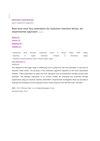Device for Inactivation of SARS-CoV-2 Using UVC LEDs
IF 0.9
4区 工程技术
Q4 ENGINEERING, ELECTRICAL & ELECTRONIC
引用次数: 0
Abstract
In connection with the COVID-19 pandemic, there is an urgent need for disinfecting devices that can be used both indoors and in transport. Currently, the most common of these devices are ultraviolet (UV) germicidal lamps. However, they have significant disadvantages, such as short service life, presence of mercury, lack of flexible control, large dimensions, etc. The paper analyzes the sources of UV radiation to find an alternative to UV lamps. Although these elements currently have low efficiency and high cost, etc., it is proposed to use UVC LEDs as a UV source. Due to the COVID-19 pandemic and the general interest in the fight against viruses, as well as the ban on the use of mercury, investments have been attracted in the development of UVC LEDs, which will make them competitive in the future compared to germicidal lamps both in cost and efficiency. The paper presents a disinfection device developed on the basis of UVC LEDs. The principle of operation is described; the control system, the drawing, and the design of the UVC LED-based disinfection device are presented. Due to the described limitations of UVC LEDs, this design can be used for disinfection of small surface areas where frequent on/off switching is required and high power is not required.UVC led灭活SARS-CoV-2装置
鉴于新冠肺炎大流行,迫切需要可在室内和交通工具中使用的消毒设备。目前,这些设备中最常见的是紫外线杀菌灯。然而,它们有显著的缺点,如使用寿命短、存在汞、缺乏灵活的控制、尺寸大等。本文分析了紫外线辐射的来源,以找到紫外线灯的替代品。尽管这些元件目前具有低效率和高成本等,但是建议使用UVC LED作为UV源。由于新冠肺炎大流行和人们对抗击病毒的普遍兴趣,以及对汞的使用禁令,UVC LED的开发吸引了投资,这将使其在未来的成本和效率方面与杀菌灯相比具有竞争力。本文介绍了一种基于UVC发光二极管的消毒装置。描述了操作原理;介绍了基于UVC LED的消毒装置的控制系统、图纸和设计。由于所描述的UVC LED的局限性,这种设计可用于对需要频繁开关且不需要高功率的小表面区域进行消毒。
本文章由计算机程序翻译,如有差异,请以英文原文为准。
求助全文
约1分钟内获得全文
求助全文
来源期刊

Elektronika Ir Elektrotechnika
工程技术-工程:电子与电气
CiteScore
2.40
自引率
7.70%
发文量
44
审稿时长
24 months
期刊介绍:
The journal aims to attract original research papers on featuring practical developments in the field of electronics and electrical engineering. The journal seeks to publish research progress in the field of electronics and electrical engineering with an emphasis on the applied rather than the theoretical in as much detail as possible.
The journal publishes regular papers dealing with the following areas, but not limited to:
Electronics;
Electronic Measurements;
Signal Technology;
Microelectronics;
High Frequency Technology, Microwaves.
Electrical Engineering;
Renewable Energy;
Automation, Robotics;
Telecommunications Engineering.
 求助内容:
求助内容: 应助结果提醒方式:
应助结果提醒方式:


